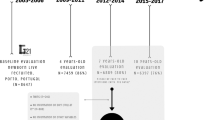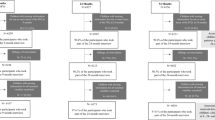Abstract
Aim:
We have previously reported on distinct dietary patterns obtained from principal components analysis (PCA) of food frequency questionnaires from 3-y-old children. In this study, we repeat these analyses at 4 and 7 y of age.
Design:
As part of regular self-completion questionnaires, the primary source of data collection in the Avon Longitudinal Study of Parents and Children, parents were asked to record the frequency of consumption of 57 different food types for their children. A total of 9550 subjects (68% of original cohort) were available from the 4-y data sweep and 8286 (59%) from the 7-y.
Methods:
Distinct dietary patterns were identified at each age using PCA. These were then related to social and demographic characteristics of the parent and child.
Results:
Three dietary patterns were established cross-sectionally at both 4 and 7 y of age to best describe the types of diet being consumed. One component at both time points described a diet based on ‘junk’-type foods with high-fat and sugar content, processed and convenience foods. A second described the ‘traditional’ British diet based on meat, potatoes and vegetables. The final, a ‘health-conscious’ pattern was associated with vegetarian style foods, rice, pasta, salad and fruit. At both time points, the ‘junk’ pattern was significantly more likely in white children, where maternal education level was low and where the child had more siblings. The ‘traditional’ pattern was more likely in girls, where the mother had a partner and in nonvegetarians (both mother and child). The ‘health-conscious’ pattern was more likely with increasing levels of education and increasing maternal age.
Conclusion:
We have demonstrated consistent dietary patterns in cross-sectional analyses at two ages in these children with similar socio-demographic associations evident at each age. Future analyses will track these dietary patterns over time and form a basis for the study of a variety of childhood outcomes.
This is a preview of subscription content, access via your institution
Access options
Subscribe to this journal
Receive 12 print issues and online access
$259.00 per year
only $21.58 per issue
Buy this article
- Purchase on Springer Link
- Instant access to full article PDF
Prices may be subject to local taxes which are calculated during checkout

Similar content being viewed by others
References
Aranceta J, Perez-Rodrigo, Ribas L & Serra-Majem LI (2003): Sociodemographic and lifestyle determinants of food patterns in Spanish children and adolescents: the enKid study. Eur. J. Clin. Nutr. 57 (suppl 1), S40–S44.
Balder HF, Virtanen M, Brants HAM, Krogh V, Dixon LB, Tan F, Mannisto S, Bellocco R, Pietinen P, Wolk A, Berrino F, van den Brandt PA, Hartman AM & Goldbohm RA (2003): Common and country-specific dietary patterns in four European cohort studies. J. Nutr. 133, 4246–4251.
Barker ME, McClean SI, Thompson KA & Reid NG (1990): Dietary behaviours and sociocultural demographics in Northern Ireland. Br. J. Nutr. 64, 319–329.
Campbell K, Crawford D, Jackson M, Cahsel K, Worsley A, Gibbons K & Birch LL (2002): Family food environments of 5–6-year-old-children: does socioeconomic status make a difference. Asia Pacific J. Clin. Nutr. 11 (Suppl), S553–S561.
Cattell RB (1966): The scree test for the number of factors. Multivariate Behav. Res. 1, 245–276.
Fung TT, Rimm EB, Spiegelman D, Rifai N, Tofler GH, Willett WC & Hu FB (2001): Association between dietary patterns and plasma biomarkers of obesity and cardiovascular disease risk. Am. J. Clin. Nutr. 71, 61–67.
Gex-Fabry M, Raymond L & Jeanneret O (1988): Multivariate analysis of dietary patterns in 939 Swiss adults: Sociodemographic parameters and alcohol consumption profiles. Int. J. Epidemiol. 17, 548–555.
Golding J, Pembrey M, Jones R & ALSPAC Study Team (2001): ALSPAC—The Avon Longitudinal Study of Parents and Children. I. Study methodology. Paediatric Perinatal Epidemiol. 15, 74–87.
Gorsuch RL (1974): Factor Analyses. Philadelphia, PA: WB Saunders.
Gregory J, Foster K, Tyler H & Wiseman M. (1990): The Dietary and Nutritional Survey of British Adults Office of Population Censuses and Surveys. London: HMSO.
Hu FB (2002): Dietary pattern analysis: a new direction in nutritional epidemiology. Curr. Opin. Lipidol. 13, 3–9.
Hursti UKK (1999): Factors influencing children's food choice. Ann. Med. 31 (Suppl 1), 26–32.
Jacques PF & Tucker KL (2001): Editorial: Are dietary patterns useful for understanding the role of diet in chronic disease? Am. J. Clin. Nutr. 73, 1–2.
Kline P (1994): An Easy Guide to Factor Analysis. London: Routledge.
Marmot MG, Davey Smith G, Stansfeld S, Patel C, North F, Head J, White I, Brunner E & Feeney A (1991): Health inequalities among British civil servants: the Whitehall II study. Lancet 337, 1387–1393.
Martinez ME, Marshall JR & Sechrest L (1998): Invited commentary: factor analysis and the search for objectivity. Am. J. Epidemiol. 148, 17–19.
McCann SE, Marshall JR, Brasure JR, Graham S & Freudenheim JL (2001): Analysis of patterns of food intake in nutritional epidemiology: food classification in principal components analysis and the subsequent impact on estimates for endometrial cancer. Pub. Health Nutr. 4, 989–997.
Mishra G, Ball K, Arbuckle J & Crawford D (2002): Dietary patterns of Australian adults and their association with socioeconomic status: results from the 1995 National Nutrition Survey. Eur. J. Clin. Nutr. 56, 687–693.
Mullen K, Williams R & Hunt K (2000): Irish descent, religion and food consumption in the west of Scotland. Appetite 34, 47–54.
North K, Emmett P & the ALSPAC Study Team (2000): Multivariate analysis of diet among three-year-old children and associations with socio-demographic characteristics. Eur. J. Clin. Nutr. 54, 73–80.
Osler M, Helms Andreasen A, Heitmann B, Hoidrup S, Gerdes U, Morch Jorgensen L & Schroll M (2002): Food intake patterns and risk of coronary heart disease: a prospective cohort study examining the use of traditional scoring techniques Eur. J. Clin. Nutr. 56, 568–574.
Rogers IS, Emmett PM & the ALSPAC Study Team (1998): Diet during pregnancy in a population of pregnant women in South West England. Eur. J. Clin. Nutr. 52, 246–250.
Sanchez-Villegas, Delgado-Rodriguez M, Martinez-Gonzales MA & de Irala-Estevez J (2003): Gender, age, socio-demographic and lifestyle factors associated with major dietary patterns in the Spanish SUN (seguimiento Universidad de Navarra). Eur. J. Clin. Nutr. 57, 285–292.
Slattery ML, Boucher KM, Caan BJ, Potter JD & Ma KN (1998): Eating patterns and risk of colon cancer. Am. J. Epidemiol. 148, 4–16.
Togo P, Osler M, Sorensen TIA & Heitmann BL (2001): Food intake patterns and body mass index in observational studies. Int. J. Obes. Metab. Relat. Disord. 25, 1741–1751.
Togo P, Heitmann BL, Sorensen TIA & Osler M (2003): Consistency of food intake factors by different dietary assessment methods and population groups. Br. J. Nutr. 90, 667–678.
Trichopoulos D & Lagiou P (2001): Invited commentary: dietary patterns and mortality. Br. J. Nutr. 85, 133–134.
Whichelow MJ & Prevost AT (1996): Dietary patterns and their associations with demographic, lifestyle and health variables in a random sample of British adults. Br. J. Nutr. 76, 17–30.
Acknowledgements
We are extremely grateful to all the mothers and other carers who have taken part in this study for several years and continue to do so. To the midwives for their cooperation and help in recruiting the mothers during pregnancy. The whole ALSPAC study team comprising interviewers, computer technicians, clerical workers, research scientists, volunteers and managers continue to make the study possible. The ALSPAC study could not have been undertaken without the financial support of the Wellcome Trust, the Department of Health and the Department of the Environment, MAFF, British Gas and other companies. The ALSPAC study is part of the WHO initiated European Longitudinal Study of Pregnancy and Childhood.
Author information
Authors and Affiliations
Consortia
Corresponding author
Additional information
Guarantor: K Northstone.
Contributors: PE designed the questionnaires, KN undertook the analyses and wrote the manuscript with the help of PE.
Rights and permissions
About this article
Cite this article
Northstone, K., Emmett, P. & and The ALSPAC Study Team. Multivariate analysis of diet in children at four and seven years of age and associations with socio-demographic characteristics. Eur J Clin Nutr 59, 751–760 (2005). https://doi.org/10.1038/sj.ejcn.1602136
Received:
Revised:
Accepted:
Published:
Issue Date:
DOI: https://doi.org/10.1038/sj.ejcn.1602136
Keywords
This article is cited by
-
Dietary patterns, lung function and asthma in childhood: a longitudinal study
Respiratory Research (2023)
-
Meatless masculinity: Examining profiles of male veg*n eating motives and their relation to gendered self-concepts
Current Psychology (2023)
-
Intake of n-3 LCPUFA and trans-fatty acids is unrelated to development in body mass index and body fat among children
BMC Nutrition (2022)
-
A traditional dietary pattern is associated with lower odds of overweight and obesity among preschool children in Lebanon: a cross-sectional study
European Journal of Nutrition (2019)
-
Ethnicity and socioeconomic status are related to dietary patterns at age 5 in the Amsterdam born children and their development (ABCD) cohort
BMC Public Health (2018)



